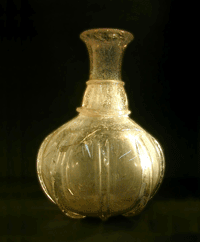Unstable elemental composition, seasonal dampness and wooden display cabinets are responsible for the disintegration of historical glass.
Unstable elemental composition coupled with seasonal dampness and wooden display cabinets are to blame for accelerating disintegration of rare pieces of historical glass at the National Museums of Scotland (NMS), report art conservation scientists.

Museum display cabinets attack the glass treasures they are meant to protect, warn the researchers. Pollutants such as acetic acid, formic acid and formaldehyde leach out of the cabinets’ woodwork. Seasonal variations in humidity in Edinburgh also play a big part in the reactions that are altering the artefacts, says Laurianne Robinet from the University of Edinburgh’s Centre for Materials Science and Engineering, and the Universit? Pierre et Marie Curie, Paris, who has been studying the glass.
Soda-silicate glass contains Na+, and reacts with moisture from the air. H+ and H3O+ ions gradually exchange with Na+ in the glass, and these ions migrate to the surface of the glass. The glass then becomes covered with a sticky alkaline film of sodium hydroxide and water. When the surface alkalinity increases above pH9, the sticky film starts to attack the underlying glass structure, which begins to flake off and crack.
Robinet’s research is based on both the Islamic and British glass collections of the NMS, all from the 19th to 20th centuries. ’This group was chosen because it contains a large proportion of the objects which are deteriorating,’ she explains.
Robinet and her colleagues gleaned information about the glassware’s chemical structure using Raman spectroscopy. They also used secondary ion mass spectrometry (SIMS) to examine the sodium content variation as a function of depth in the glass.
The team recreated a number of ’accelerated ageing’ scenarios in the lab, to find out how the sodium in the glass, the moisture from the air and the organic solvents from the cabinets interacted. The researchers found that when the glass was subjected to humidity alone the pH of the solution at the surface was high, due to the formation of sodium hydroxide through the ion-exchange, and so the silicate bonds in the glass were attacked.
But the combination of the organic pollutants with humidity created an acid atmosphere, which accelerated the ion exchange reaction that leached the sodium ions out of the glass structure. In that case, the sodium hydroxide solution formed was neutralised by the acidic pollutant, which reacted with the sodium ions to form crystalline corrosion at the surface of the glass.
In the acid atmosphere, the second stage - the dissolution of the silicate network - was slowed. The Raman results suggested that, although the structure of the altered layer is very different, in both cases new bonds are subsequently formed as the hydrated silicate structure re-polymerised.
Helen Carmichael






No comments yet